#belgian revolution
Text
The Uses of History, 14 – France, Revolution #4, 1870-1, Part 1
The Uses of History, 14 – France, Revolution #4, 1870-1, Part 1
(Photo credit – Louis Napoleon Bonaparte, 1849 – Wikimedia Commons)
Until 1871, no one in continental Europe or anywhere in the world with knowledgeable connections to Europe, as in North America or areas under European domination in other continents, questioned that the greatest European power after the United Kingdom was France. Britain, as unchallenged mistress of the world’s oceans and the…

View On WordPress
#Belgian Revolution#Congress of Vienna#Emperor Napoleon III#French Revolution 1870-71#Holy Alliance#Louis-Napoleon Bonaparte#Metternich#Polish Revolt 1831#Revolutions of 1848
1 note
·
View note
Text

Found a wikipedia article called: "List of classical music concerts with an unruly audience response" and literally this is the funniest shit I've read in a long time
#not your opera getting upstaged by the belgian revolution#also more poor boy rossini#opera#classical music#music#bern speaks
310 notes
·
View notes
Note
Tell that to Belgium lol (The literal only time literature actually directly produced a revolution, but hey it worked once).
Oh hey, literature/art itself can certainly play an important political role! You could equally have mentioned harriet Beecher stowe, or for that matter any number of works of national propaganda
What is basically entirely politically impotent is artistic criticism: no revolution for good or ill has ever been or will ever be sparked by a roger ebert essay, let alone deconstruction. Which is no discredit to roger ebert! There are plenty of worthwhile activities of little political significance. But it bothers me when ppl insist it must be greatly politically meaningful anyway
#ask#anon#re: Belgian Revolution#also always warms my heart to think of catholic-led proletarian movements!#toussaint louverture is another example
15 notes
·
View notes
Text
Antigone in the Amazon is (overall!!!!) incredibly incredibly incredibly good. Theatre is like high school football. The highs and lows.
#sorry it's just. antigone was so good ans last weeks thing was so bad (SO bad)#and antigone for the record was like 90% good 10% stuff i needed a dramaturg for#which usually i wouldn't even mention if its that type of ratio except that what was bad was very much this sense of the flemish theatre#makers overstepping into the stories they were telling. it was like it was 45% indigenous Brazilian stories and 55% belgian#and that 5% really does nag#but ! its (to an extent) nitpicking it was truly truly excellent if its ever at a festival near you i do recommend#or a theatre but i dont have a lot of be/nl followers so#i was actually very interested by the restructuring of polynices' role when comparing him to a real life martyr whose story they told before#the prologue (or ig as the prologue) and there was so much that was just so brilliant about it#my mom said it was revolutionising the shape of theatre which i wholeheartedly disagree with but it was an incredible story abou ~revolution#(its not lit about revolution but it has the soul of it)#in terms of theatre forms its very much on par with the current trends (where im from anyway) but it did do it very well#bc it was quite heavy on the projection and while i usually say that projection in theatre is a sign of bad times it was so well done#so ig if you wanna call that revolutionary then sure but not really#ugh it was so good
0 notes
Audio
“Our Revolutions,” a 2022 single by San José, Costa Rica-based post-punk and darkwave band MOLT, featuring Belgian coldwave solo artist Severine Day
#darkwave#coldwave#postpunk#goth#MOLT#Our Revolutions#singles#music#Costa Rican#Central American#Severine Day#Belgian#international goth#2022#2022 singles#Costa Rican goth#Belgian goth
0 notes
Text
So there's this small fly that keeps on flying near my dog but just out of reach and I swear you not that flys on its last wings
#like matey Max is on a mission#thank god the prey drive was useful for something other than acting like hes high for *at least* 23 hours a day#forget the ghostbusters#max is gonna start a revolution#hes read the renfield updates and got ideas lol#belgian malinois#belgian shepherd#mali
0 notes
Text
Somewhat ironically, direct contact with Europe had always been important for fomenting revolutionary movements in the Third World. The Indonesian independence movement had early roots in Holland, and it was in Paris that Ho Chi Minh got his political education. When studying or working back in the imperial capitals, colonial subjects often came into contact with ideas that were never allowed to reach their territories. Much of colonialism had relied on the logic of “Do as I say, not as I do.” Or in practice, “Do as white say, not as white do.” So while Europeans themselves were extending education to their entire populations, and their intellectuals were debating the merits of socialism and Marxism, much of this was banned in the colonies. The natives might get ideas. For example, in the Congo, brutally controlled by the Belgians since King Leopold II established the Free Congo State in 1885 (and the United States rushed to be the first country in the world to recognize the colony), authorities banned left-leaning publications and liberal lifestyle magazines that circulated freely back in Europe, and were scared even by the fact that working-class blacks lived together in urban areas. Wouldn’t this lead to subversion, or worse, Bolshevism? Congolese pupils learned about the Belgian royal family, but not the American civil rights movement, and the French Revolution was explained very carefully, so as not to make that whole affair seem too attractive in African editions of textbooks.
The justification given by European authorities in the Congo went like this: “All those in our colony are unanimous in stating that the blacks are still children, both intellectually and morally.”
Vincent Bevins, The Jakarta Method
#book club#reading this book and thinking about the schools and universities destroyed and occupied in gaza…
234 notes
·
View notes
Text


Pieper M1893 Revolver Carbine from the United Mexican States dated to the 19th Century on display at the National Museum of History in Mexico City, Mexico
The Belgian gunsmith, Henri Pieper, developed the weapon and began to supply it to the Mexican government under the Dictator President Porfirio Díaz. The weapons were supplied to the Rurales, rural mounted police that were used to suppress unrest in the Mexican countryside prior to the Mexican Revolution in 1910.
The Rurales were advertised as an effective and often ruthless force similar the Canadian Mounties and Texan Rangers. Indeed their uniforms and equipment were selected to seperate them from the Federal Army. However they were too few in number to form an effective force outside of Mexico City.
Photographs taken by myself 2024
#cavalry#19th century#mexico#mexican#victorian#militayr history#national museum of history#mexico city#barbucomedie
66 notes
·
View notes
Text
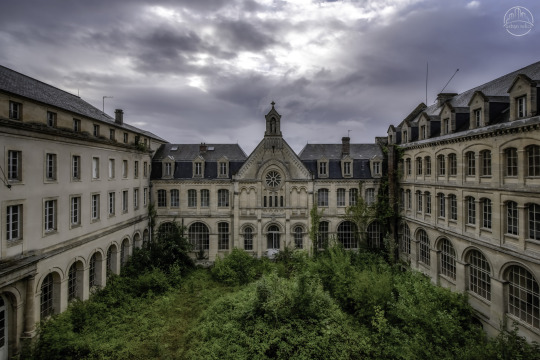
HOPITAL PLAZA
This imposing ensemble, commissioned by the French King Louis XVIII in 1820, is known in urbex circles as 'Hôpital Plaza', although it was only effectively used as a hospital for a very short period at the end of the First World War. During that period, more than 8,000 - mainly Belgian - wounded soldiers were cared for.
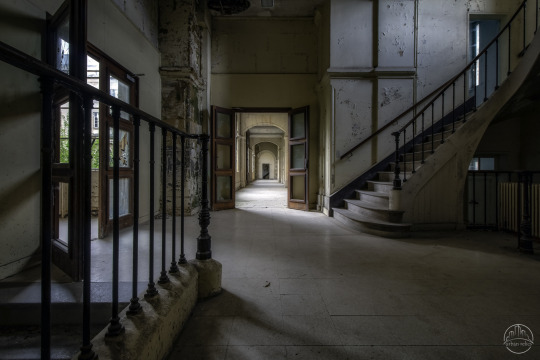
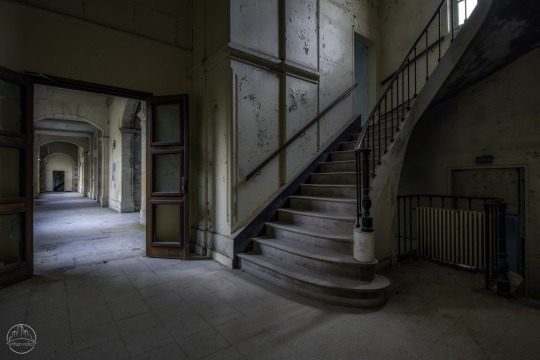
After the French Revolution, the Catholic fire again raged very strongly in the west of France, especially in Normandy, and there was a need for training opportunities for young men who felt called to the priesthood. Two wealthy residents donated the necessary land to the diocese to establish a "minor seminary" on this site. The ensemble became an architectural replica of the nearby 'major seminary'. Young seminarians first followed a course here, after which they completed their training in the major seminary.
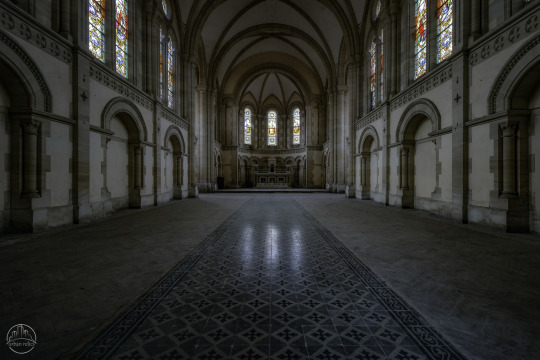

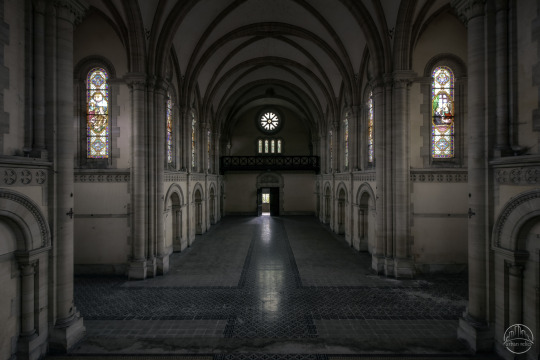
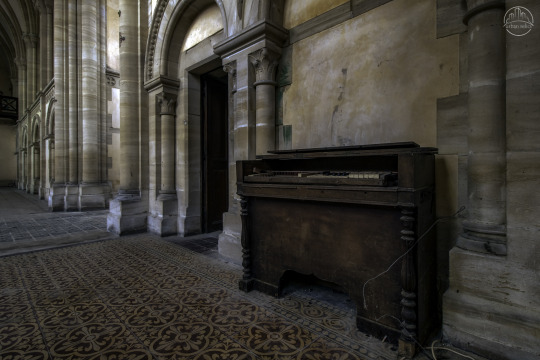
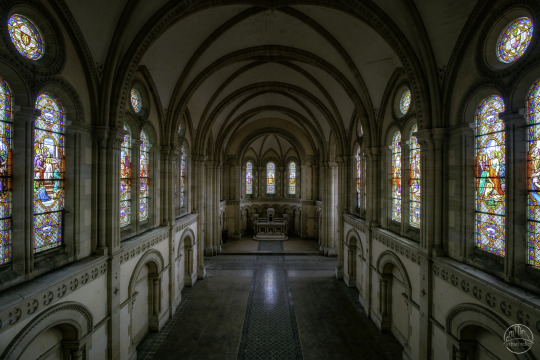
The Minor Seminary not only welcomed young people who were destined for the priesthood; it also gave access to general education, both for sons of wealthy families and those of families from more humble backgrounds. The school survived until 1905, when the French church and state were once again separated.

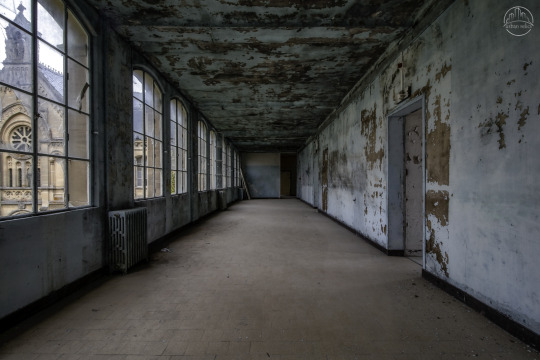




At the end of the First World War, the building became a shelter for veterans. After all, at the end of the fighting, many disabled soldiers could no longer support themselves. The Minor Seminary became a home to welcome them. Retired veterans joined later. Many affected French families also found temporary shelter here during the Second World War, after which the buildings resumed their function as a retirement home for veterans.
In June 2000, it was abandoned completely and was sold to a businessman from Lyon, who intended to install 70 luxury apartments. Much to the chagrin of the local government, the plans were never realized and the old seminary began to deteriorate. Since 2016 it has been owned by Spanish property developers, who were supposed to look for a new destination. The local government now wants to start an 'abandonment' procedure to expropriate the whole ensemble, hoping to give the beautiful seminary a new lease on life.
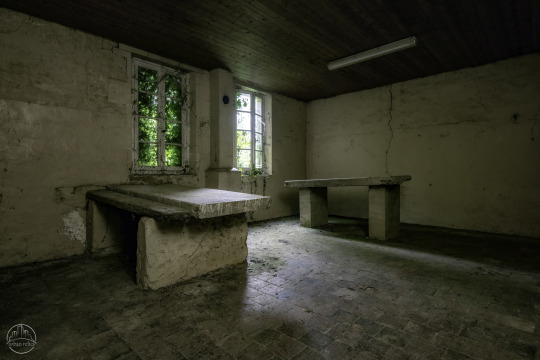

#urban exploration#urbex#abandoned#urban relics#decay#derelict#abandoned places#ue#photography#urbanexploration#france#photographer#hopital#plaza
155 notes
·
View notes
Text

Oil on canvas, Charles Louis Mozin
The Capture of the Dutch Fleet at Den Helder, 23rd of January 1795
In which the French armed forces demonstrates that not having the best navy can in fact be okay.
Context
The French Revolution in 1789, followed by the imprisonment and then execution of Louis the XVIth in 1793, led to most major autocratic powers in Europe declaring war on France to restore the status quo. France was thus engaged on multiple fronts by many of its neighbors which, surprisingly, at the time included Austria through their ownership of the Southern Netherlands. Both Netherlandses had witnessed failed republican uprisings in the previous decades, and as such the new France Republic pushed through the Austrian Netherlands to declare war on the -nominally only- Republic of United Netherlands in the North.
The “Battle”
After two years of campaign the combined efforts of the French revolutionary army and Dutch patriots had all but closed this front of the war, and the French commander of the Army of the North was garrisoned in Amsterdam when he caught wind of the Dutch fleet being anchored at the mouth of the Zuiderzee bay, just north of there. Due to temperatures averaging -10°C in the past weeks, the entire bay had frozen over, which he decided to use to his advantage.
He immediately sent Dutch patriot Gnl. Jan Willem de Winter at the head of about two hundred men from the French 8th Hussar and the 3rd Battalion of Belgian Skirmishers, also raised from sympathizers to the republican cause. Muffling the sound of their horses’ hooves with cloth and arriving during the night each with a Belgian infantryman riding with them, the hussars sneaked on the entire Dutch fleet frozen at anchor and captured it without a fight.

In a single cavalry charge the French Republic had captured five ships-of-the-line, three frigates, six corvettes and several merchantmen with crew, for a total of about 850 guns. This is one of only two recorded instances of a cavalry force charging and capturing ships in a battle and one of few instances where having light infantry ride as voltigeurs proved to be even remotely useful.
There is debate whether the Dutch sailors and marines would have actually resisted capture however, as the Netherlands had essentially already been knocked out of the war by then and might have been ordered to surrender, which the French may have known as well. It is hard to discern the truth of the matter when what was two hundred men sent to secure a fleet that may have already been surrendered to them gets painted as a full army corps marching in tight formation on the ice.
In any case, a squadron of hussars captured a fleet of ships and that’s awesome.
Following the capture of the fleet, the evacuation of the remaining Allied troops to other fronts or England and finally the surrender of the Austrian duchy of Luxembourg, the Dutch Patriot party were given the reins of the Netherlands renamed as the Batavian Republic - more or less a puppet state and the future Netherlands - while the Austrian Netherlands - future Belgium - and Luxembourg were incorporated in the French Republic as new departments.
The captured fleet was ransomed back to the Batavian Republic in exchange of a small loan of a hundred million guilders.
235 notes
·
View notes
Note
Now I'm curious: what happened to Tallien to consider him a worse loser than Barras? I only know his involvement in Thermidor and the fact that Theresia left him after all the mess he did to go with a richer banker... Did he embarrass himself in other ways?
How much time do we have? Look, I don't know a lot about Barras, but nothing - nothing - can be as embarrassing as Jean-Lambert Tallien. He is the biggest loser both in terms of "a flop" and "who lost during the revolution" (and he lost more than many people who ended up guillotined, imo).
And I don't even know how/why it happened! He started out okay - he had modest skills but seemed honest about the revolution. Then Bordeaux happened. Thermidor and months after were Jean-Lambert's five minutes of fame, but then it dissolved quickly, both in his professional and in private life.
The Quiberon Invasion mess in 1795 is one of the first examples, when he and Hoche (well, Tallien mostly because it was his orders) executed 750 royalists even after promising they'd be treated like prisoners of war. Yes, those were royalists who made an invasion on France so it's not surprising that they died, but 1) Hoche I think promised they'd be spared but Tallien ordered the execution, 2) Tallien was the one who ran his mouth so much after Thermidor about sparing people and now he executed in one day half of the number of people that were executed in the entire Great Terror, and 3) Seems like Tallien had some pro-royalist dealings/conversations with foreign powers (Spain mostly) and wanted to do a cover-up (? - will need to look into this further).
In his private life, Theresia wanted to leave him as early as 1796 and was reportedly banging Barras, but Tallien begged her to give him another chance. She said yes, and 9 months later she gave birth to a stillborn boy. We are not sure if the baby was Barras' or Tallien's.
Life in the Directoire was not great for Jean-Lambert and he was struggling with money, so he joined Napoleon's expedition to Egypt. It was horrible; he was miserable and suffered health problems. He wrote clingy letters to Theresia ("Care for our daughter and be faithful to me, my love!") (Spoiler: She was already on kid number two by the banker). The letters were intercepted by the enemy and read publicly. On his way from Egypt, Tallien was arrested and spent some time with the enemy but was released. Coming back from France must have been horrible, though, because Theresia asked for a divorce (and by the time it was done, she was already pregnant with banker's baby number 3). Because the kids were technically conceived while she was married to Tallien, they later successfully asked to have Tallien as their last name and were known as "Tallien bastards" in the family.
After, it was just a series of bad circumstances and decisions. Theresia remarried, to a Belgian prince, and we have a letter where Tallien begged her not to do that. Fouché tried to help him and found him a job in Alicante. But it was horrible because the whole town was infected by the Yellow Fever. Tallien contracted it and lost one eye. It is also possible that this is where he got leprosy (?)
When he got back to France, he was a ruin. He supported Napoleon in 1815, hoping to get some influence (I assume), but then Waterloo happened so another bad call for Jean-Lambert. He lived in poverty and only escaped banishment during the Bourbon restoration because of his poor health. He died at 53 of leprosy (at least wiki claims so - I could never verify it but we know he suffered poor health for years).
And on top of that - on top of that! - his magnum opus, his legacy, the thing that lives on for 200+ years, is not associated with him. Nobody knows of Jean-Lambert Tallien and his most crowning achievement: the invention of the Terror and evil mastermind Robespierre. Sure, he wasn't the only one involved in that, but he did play a crucial role and, arguably, it is the most historically important thing that he did. And nobody knows it was him! So many people hate Robespierre for 200+ years, but nobody knows who is responsible for forging that smear campaign. (Yes, I am aware that it's the point: if people knew it was constructed, and by specific people, they wouldn't view it in the same way, because the main thing about the Terror how it's seen is that it's an objective thing that happened just as described. But allow me this Tallien rant).
So.. yeah.
42 notes
·
View notes
Note
what got you so into the french revolution?
When I was in school for medieval art history, I did a lot of work on saints and their martyrdoms, particularly how the viewers of art depicting suffering imagined suffering, and how the agony/eroticism of those feelings induced a sort of memetic spiritual euphoria. Which means that I spent a ton of time looking at images of executions. I've seen them all: beheadings and sexymen shot full of arrows, saints barbecued or flayed or eaten by wild animals, criminals broken on the wheel -- all the classics. Or at least, I thought I had, until I encountered this triptych in my senior year of college:

This, by Belgian artist Antoine Wiertz, is The Visions of a Guillotined Head, painted in the late 1840s. Wiertz was a symbolist, and spent a great portion of his career drawn to the macabre, never more notably than on the occasion that inspired this painting.
In February 1848, two notable French criminals were due to be executed by the state. The guillotine was of course still in use as a method of capital punishment (and would be until the 1970s), and Wiertz was curious as to what a so-swiftly severed head felt and saw. He wasn't the first; since the guillotine's invention there had been legends of heads that blinked and blushed and tried to speak after separation. Luckily, Wiertz had a friend who was a hypnotist (as you do). Timed to the moment of the execution, he had his hypnotist pal put his soul "into rapport" with the dead criminal, and claimed that he entered the head itself as it fell.
He later recalled his experiences at some length in writing, but since we're talking about me, here is the important passage, dictated as he "felt" the horror of execution:
A horrible buzzing noise, the sound of the blade descending. The victim believes that he has been struck by lightning, not the axe. Astonishingly, the head lies under the scaffold and yet still believes it is above, still believes itself to be part of the body, and still waits for the blow that will cut it off. Horrible choking! No way to breathe. The asphyxia is appalling. It comes from an inhuman, supernatural hand, weighing down like a mountain on the head and neck. A cloud of fire passes before his eyes. Everything is red and glitters.
Now comes the moment when the executed man thinks he is stretching his cramped, trembling hands towards the dying head. It is the same instinct that drives us to press a hand against a gaping wound. And it occurs with the dreadful intention of setting the head back on the trunk, to preserve a little blood, a little life.
This fucked me up so bad.
I am well aware that consciousness after having your spinal cord severed is a done deal. I was aware of this in college. But there was something about this artist's act of imaginative empathy that compelled me, for the first time, to think about the guillotine in particular. About the mechanical wait, not being pushed off a drop or axed while kneeling, about being slid through on a board, of seeing the basket beneath you, already full of heads. Maybe even heads you know.
I imagined it so hard that I made myself sick and couldn't go to class for two days.
The reason I studied what I studied wasn't because I was ghoulish. In fact, I'm a little squeamish. It was because in the experience of pain, we are all deeply individualized, but entirely, helplessly human.
I laid in bed and thought about the small number of humans who I, an educated layman, knew had been guillotined: Marie Antoinette, obviously; Louis XVI; and (in what felt like black historical irony, given what I knew of his day job) Maximilian Robespierre.
It felt intrusive to have intimately imagined their last, most private moments, without really having any idea about them at all. Better to start at the end and work backwards, I thought. So I started reading.
Robespierre, decapitated by guillotine when he was thirty-six. That's the manner of death. How did he meet his death? In terrible pain, I learned. Why? Because he'd had half his jaw blown off the night before. Jesus, why? Because he'd (maybe probably) shot himself. Why?
It turns out, if you keep doing that, a piece at a time, for years, you can learn a lot about someone's life. And, relatedly, in long and branching paths, you can find your way into every nook and cranny of what burned through France at the end of the 18th century.
#aren't you glad you asked#hey emily why were you so obsessed with executions and the horror of suspended pain in the first place?#well yes you see I was raised evangelical and read foxe's book of martyrs at the tender age of eight and it drilled a channel into my brain#hey emily did something happen to you in college that made you hyperfocus on the gossamer threads between life and death?#would you look at the time!!!!#anyway this was probably not the answer you expected but it is what it is#I have seen the past and I foresee the future
94 notes
·
View notes
Text


There is nothing particularly unusual about it: the Western fascination with Yugoslav modernist monuments, those strange concrete boulders scattered across the failed state, is renewed at regular intervals. Four years ago, for example, the Belgian photographer Jan Kempenaers published a photo monograph 'Spomeniks': 'Raised in peaceful fields, in the middle of nowhere', the respected Guardian introduced his book at the time, 'spomeniks look like places where alien spacecraft have landed or like album covers Pink Floyd.'' The filming of the new Netflix dystopian series 'The Tribes of Europa', which tells the story of the distant future of a continent divided - this will sound familiar - into numerous, small, mutually warring states, was completed on Petrova Gora these days. And so on, and so on, further and further away from what Yugoslav monuments used to mean: if there is something in common with all these advertising campaigns, dystopian TV-fantasies and photo-safaris around the places of the people's uprising, it is a complete lack of interest in historical, political and the artistic context from which the monuments grew. In the Western perspective, they are now only gigantic exotic souvenirs from a distant and incomprehensible past. Alien apparitions for which we do not know who exactly built them, when and why: rather traces of UFOs than signs of people's liberation war. Mark O'Neill's series of instagram photos, devoid of any information about the monuments other than the elementary mention of their locations, fits perfectly into such a tradition.
So nothing new from the west. Perhaps that is why it is more interesting to check what is happening with the monuments today from the perspective of the East. Coincidentally, last week, just as the post-Yugoslav news portals were compulsively copying O'Neill's photo gallery, another anniversary of the demolition of the magnificent Monument to the Victory of the Revolution of the People of Slavonia by Vojin Bakić, which was erected in Kamenska near Požega, on February 21, 1992, passed almost unnoticed. Members of the 123rd Brigade of the Croatian Army in a well-organized mine action expertly removed them from the face of the earth. Only the small portal Antifašistički Vjesnik reminded of the sad anniversary by publishing a photo gallery of the ruins, along with a brief overview of the then propaganda lies from the local media about how the monument was broken by the Chetniks or, possibly, by a strong wind. But the ruin of Bakić's monument are not very photogenic, there are no spotlights or Instagram filters, it cannot serve as an advertising scenography, so the article from Antifašistički Vjesnik was not shared by anyone. No one to press copy, no one to click and paste: the anniversary of the destruction of one of the most beautiful monuments of the former Yugoslavia did not become news this year either. There is simply no room for some stories in the colorful, colorful, clickable memory of the media, just as there was none twenty-eight years ago. After all, what do you want: it was a war, we clicked cut.
Boris Postnikov, 2020
41 notes
·
View notes
Note
Do you have any personal favorite queer books set in not-primarily-anglophone countries?
I do! Here are my personal favourites:

[image description: the covers of five of the books listed]
Butter Honey Pig Bread by Francesca Ekwuyasi (review), set in Lagos
Painting Their Portraits in Winter by Myriam Gurba (review), set partly in Mexico and partly in the U.S.
Miss Timmins’ School for Girls by Nayana Currimbhoy (review), set in India
The Salt Roads by Nalo Hopkinson (review), set in several countries, including the Caribbean
Everfair by Nisi Shawl (review), set in an alternate Belgian Congo
The Unbroken by C.L. Clark (review), set in a world inspired by North Africa
Before the Rain: A Memoir of Love & Revolution by Luisita Lopez Torregrosa (review), takes place in several countries, including the Phillipines
Aimée & Jaguar: A Love Story, Berlin 1943 by Erica Fischer, nonfiction in Germany
Manga, set in Japan:
I Married My Best Friend to Shut My Parents Up by Naoko Kodama (review)
How Do We Relationship? series by Tamifull (review)
My Lesbian Experience with Loneliness by Kabi Nagata (memoir)
222 notes
·
View notes
Text











Vianden Castle is located in Vianden in Luxembourg. The castle was built on the site of an ancient Roman castellum and served as the seat to the Counts Vianden until the beginning of the 15th century. Built on a high rock overlooking the town, the castle was constructed in the Romanesque style from the 11th to 14th centuries, with Gothic transformations added toward the end of the building period. In the 17th century, a Renaissance mansion was added to the site. In 1820, King William I sold the castle to an alderman named Wenzel Coster. Wenzel demolished the building and sold it in pieces, which left it a ruin. Bothered by the mistreatment Wenzel dealt the castle, the king repurchased the ruin with the desire to restore it, but by then the Belgian Revolution was underway. It wasn’t until 1851 that Prince Henry of the Netherlands began to restore the castle. Prince Henry commissioned the work on the chapel at his own expense. In 1890, further restorations were made by the Grand Duke of Luxembourg. During WWII the castle was defended against the Waffen-SS by the Luxembourg anti-Nazi resistance. In 1962, restoration began again with the armory, until questions of the castle’s ownership slowed the progress. In 1977, the Grand Duke transferred ownership of the castle to the state and the work continued and was completed in 1990. Vianden Castle boasts a courtyard, an arms hall, a crypt, a chapel, a Knight’s Hall, a dining hall, a vaulted grand kitchen, an early kitchen, a water well, a Byzantine Gallery, and a genealogy room. #Castles #Luxembourg #Vianden #ViandenCastle #history
9 notes
·
View notes
Text
Slightly bitter about a lot of "this is all the fault of the brits" "this is the inevitable result of Sykes-Picot" "This is a post-British Empire conflict, on par with the partition of India". To me this sounds so so so cynical. The US had a civil war with 620 000 dead a mere 85 years after independence. Did the British provoke that ? The Cuban Revolution happened 40 years after its independence. Was it the consequence of Spain's actions ? Algeria was torn apart by a civil war that claimed 150 000 dead, a mere 29 years after independence. Did France cause that war ? Was the Rwandan genocide perpetrated by Belgians ? When Pakistan supports the Taliban & Al-Qaeda, is Tony Blair the mastermind behind that ?
Israelis fought for their independence. Whether you think of it as a brutal colonial war supported by imperial powers or as a national struggle for sovereignty and a safe homeland, they weren't exactly "given the keys to the house". They chose their own political institutions, have had multiple political parties in open conflict, and, compared with the immense majority of post-colonial nations, their domestic politics have been fairly free from outside interference.
The British mandate lasted 31 years. Israel has been independent for 75 years. At this point, people posting Israel apologia saying that the country is only reaping what the British have sown are akin to people at a retirement home who still complain about their college roommate ruining their marriage, career and front lawn. There were 75 years where it was possible to change this state of things. They weren't. Why is that ?
22 notes
·
View notes